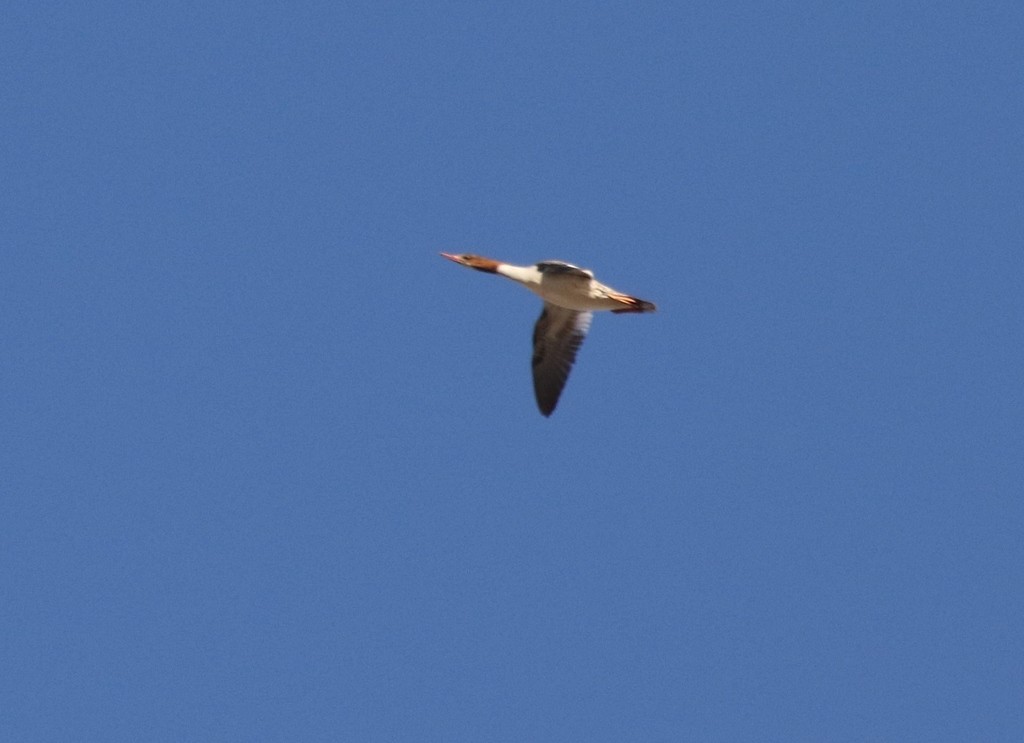Common Merganser
A species of Typical mergansers, Also known as Big Pond-sheldrake, Big Fish-duck, Dun-diver Scientific name : Mergus merganser Genus : Typical mergansers
Common Merganser, A species of Typical mergansers
Also known as:
Big Pond-sheldrake, Big Fish-duck, Dun-diver
Botanical name: Mergus merganser
Genus: Typical mergansers
Content
Description People often ask General Info
 Photo By silversea_starsong , used under CC-BY-NC-4.0 /Cropped and compressed from original
Photo By silversea_starsong , used under CC-BY-NC-4.0 /Cropped and compressed from original Description
The common Merganser is a large duck that postpones migration in the winter until the rivers, lakes, and ponds freeze. While the bright-colored head makes it easy to identify, males, juveniles, and females have darker-colored bodies. The duck feeds by diving into the water in search of small fish.
Size
56 - 69 cm
Life Expectancy
10 years
Nest Placement
Cavity
Clutch Size
6 - 17 eggs
Incubation Period
1 brood
Number of Broods
28 - 35 days
Nestling Period
1 - 2 days
Feeding Habits
Common Merganser's diet is predominantly fish, also consuming various aquatic invertebrates - insects, mollusks, crustaceans, and worms, alongside occasional frogs, small mammals, birds, and plants. They forage in clear, shallow waters, using eyesight and serrated bills to probe and grasp prey. Diet varies seasonally, with increased fish consumption in winter and more invertebrates during breeding. Nestlings primarily consume invertebrates, progressing to fish with age.
Habitat
Common Merganser predominantly inhabit northern forested regions adjacent to sizeable lakes and rivers. They have an affinity for mature forests due to their nesting preference for large tree cavities. In terms of altitude and climate, common Merganser are adaptable, ranging from lowland freshwater habitats to upland regions. Seasonal migrations lead common Merganser to spend winters in southern locations, encompassing large inland water bodies as well as coastal regions, though they show a bias towards freshwater habitats over coastal bays and estuaries.
Nest Behavior
The female common Merganser selects the site and forms the nest before laying eggs. After egg deposition, she lines the nest with her own down. Both parents share in caring for the young, with the female often leading the brood to water soon after hatching.
Nest Characteristics
Common Merganser typically nests in natural cavities or woodpecker holes within trees, often up to 100 feet high and close to water. Less commonly, they use rock crevices, chimneys, or even nest boxes intended for other species. The nest bowl is shaped from accumulated debris and lined with down feathers from the female’s breast.
Dite type
Piscivorous
People often ask
General Info
Feeding Habits
Bird food type
Bird Feeder Type

Platform
Behavior
Common Merganser are gregarious waterfowl often seen in flocks of up to 75, spending their time swimming, fishing, and occasionally loafing on open water. These birds exhibit synchronized diving in groups while foraging, rarely submerging for more than 30 seconds. Males engage in animated courtship chases, occasionally leading to physical contact. A notable behavior is their brood parasitism, with females laying eggs in conspecifics' nests or those of other species. Post-nesting, males typically leave, while females solely escort ducklings to larger water bodies, navigating predation threats from raptors to large fish. Ducklings coalesce into large, mixed-age broods for enhanced safety.
Species Status
Overall, the species is not threatened, though illegal persecution by game fishing interests is a problem in some areas. Within western Europe, a marked southward spread has occurred from Scandinavia in the breeding range since about 1850, colonising Scotland in 1871, England in 1941, and also a strong increase in the population in the Alps. The goosander is one of the species to which the Agreement on the Conservation of African-Eurasian Migratory Waterbirds applies. 
Scientific Classification
Phylum
Chordates Class
Birds Order
Waterfowl Family
Geese Genus
Typical mergansers Species
Common Merganser